How to create a good meta description

A strong meta description boosts CTR and signals relevance to search engines. This post shows how to craft descriptions that work, with practical tips and ready-to-use templates. You’ll learn the traits of good meta descriptions, common mistakes, and how Yoast SEO can help you get it right. Using these templates and guidelines can boost CTR, align reader expectations, and improve optimization for both users and Google.
Did you get a red traffic light for the keyphrase in the meta description check in Yoast SEO? Read what this check does, and how to turn this traffic light green. Yoast SEO also checks the length of your meta description. Read about how that check works and how to write a concise meta description.
What is a meta description?
The meta description is an HTML tag you can set for a post or page of your website. In it, you can use roughly 155 characters to describe what your page is about. If you’re lucky, Google will show it beneath your page’s title in the search results. It allows you to convince search engine users that your page will offer what they are looking for.
In Google’s search results, this is where it can be displayed:

And this is what it looks like in the HTML code of the page:
<meta name="description" content="Your site structure is vital for users and SEO. Our complete guide will guide you through all the steps to create a sound site structure." />Why set a meta description?
The purpose of a meta description is simple: it needs to get someone searching with a search term on Google to click your link. In other words, meta descriptions are there to generate click-throughs from search engines.
Search engines say there is no direct SEO benefit from the meta description – they don’t use it in their ranking algorithm. But there is an indirect benefit: Google uses click-through rate (CTR) to determine whether you’re a good result. If more people click on your result, Google considers you to be a good result and will, based on your position, move you up the rankings. This is why optimizing your meta description is important, as is optimizing your titles.
Unfortunately, there is no guarantee that Google will display the description that you’ve written. But, as there is a chance it will, adding it to your post or page is always worth the effort.
What does a good meta description contain?
Here’s a list of elements you need to write a good meta description:
- Keep it up to 155 characters
- Use an active voice and make it actionable
- Include a call to action
- Use your focus keyphrase
- Show specifications when needed
- Make sure it matches the content of the page
- Make it unique
Let’s go over them in detail!
1. Keep it up to 155 characters
The right length doesn’t exist; it depends on the message you want to convey. You should take enough space to convey the message, but keep it short and snappy. However, if you check the search results in Google, you’ll mostly see snippets of 120 to 156 characters, like in the example below. Google says you can make your meta descriptions as long as you want, but there is a limit to what we can see in the SERPs — and that’s around 155 characters; anything longer will get truncated.

Unfortunately, you can’t fully control what Google displays in the search results. Sometimes, it shows the meta description, and sometimes, it just grabs some sentences of your copy or generates something itself. Either way, your best bet is to keep it short. That way, if Google does decide to show the description you’ve written, it won’t be cut short.
2. Use active voice and make it actionable
If you see the meta description as an invitation to visit your page, you have to think about your user and their (possible) motivation to visit your page. Ensure your description isn’t dull, difficult, or too cryptic. People need to know what they can expect to find on your page.
The example in the image below is the description you should strive to write. It’s active, speaks to you, and addresses you directly. You know what you’ll get if you click on the link!

3. Include a call-to-action
“Hello, we have a new product, and you want it. Find out more!” This overlaps with what we said about the active voice, but we wanted to emphasize it again. The meta description is your sales text. In this case, the “product” you are trying to sell is the linked page. Invitations like Learn more, Get it now, Try for free come in handy, and we use them too.

4. Use your focus keyword
If the search keyword matches a part of the text in the meta description, Google will be more inclined to use it and highlight it in the search results. This will make the link to your site even more inviting. Google sometimes even highlights synonyms. In the example below, both the Academy Awards and Oscars are highlighted. Getting your results emphasized like that makes them stand out even more.

5. Show specifications, where possible
If you have a product in your Shopify or WooCommerce store aimed at the tech-savvy, it can be a good idea to focus on the technical specs. For example, you can include the manufacturer, SKU, price, etc. If the visitor specifically seeks that product, you won’t have to convince them. Can the watch help us stay fit? Sign us up; that’s all we need to know. Note that to optimize your result in this manner, you should work on getting rich snippets.

6. Make sure it matches the content of the page
This is an important one. Google will find out if you use meta descriptions to trick visitors into clicking on your results. They might even penalize you if you do it. But besides that, misleading descriptions will also increase your bounce rate. Which will also lower people’s trust in your company. It’s a bad idea for that reason alone. That is why you want the meta description to match the content on the page.
7. Make it unique
If your meta description is the same as those for other pages, the user experience in Google will be hampered. Although your page titles might vary, all pages will appear the same because all the descriptions are identical. Instead of creating duplicate meta descriptions, you’d better leave them blank. Google will pick a snippet from the page containing the keyword used in the query. That being said, writing a unique meta description for every page you want to rank is always the best practice.
How Yoast SEO helps you write meta descriptions
Adding a meta description is easy if you’re on WordPress or Shopify and using Yoast SEO. Firstly, you can write it in the Search appearance preview section of Yoast SEO. But Yoast SEO also gives you feedback on it in the SEO analysis. The plugin checks the meta description length and whether you’ve used your focus keyphrase. So, let’s see how the plugin helps you and what you can do with it.
Using AI to generate meta descriptions in Yoast SEO Premium
Yoast SEO Premium has our Yoast AI Generate features, which include AI-powered meta description generation. This meta description generator brings the power of generative AI to your fingertips, producing engaging and SEO-optimized meta descriptions with just one click. Using advanced algorithms and machine learning techniques, it generates creative and appealing meta descriptions, captivating your audience while meeting search engine standards.
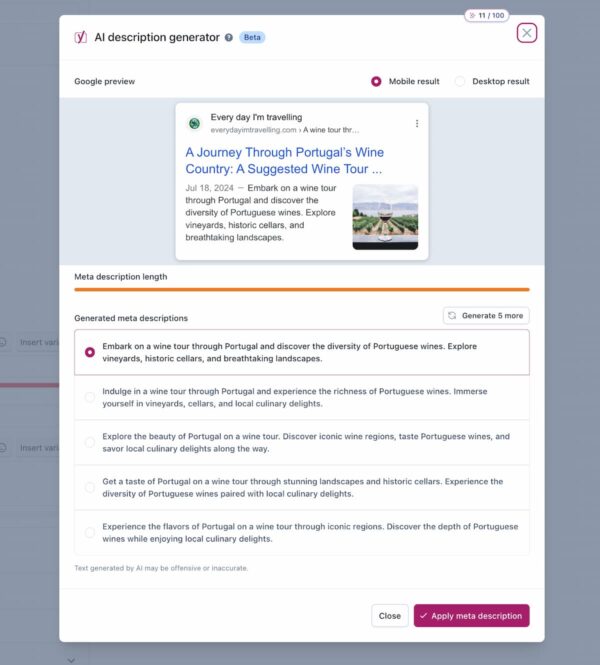
This feature simplifies your meta description optimization process and fully complies with best SEO practices. It enhances user experience, amplifies your website’s visibility, and effortlessly directs high-quality, organic traffic to your site. With this outstanding AI generator, effortlessly elevate your SEO performance and generate outstanding meta descriptions that set you apart.
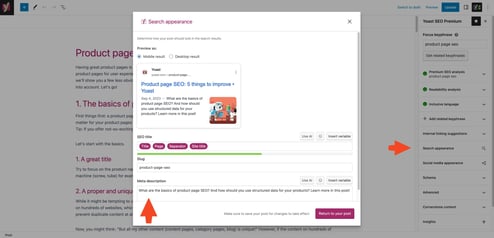
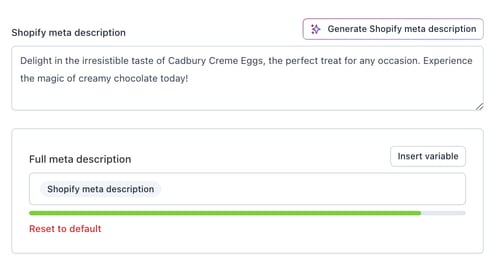
What does the keyphrase in meta description assessment in Yoast SEO do?
This check is all about using the keyphrase in the meta description. A focus keyphrase is the search term you want a page to rank for. When people use that term, you want them to find your page. You base your keyphrase on keyword research. After your research, you should end up with a combination of words that most of your audience will likely search for. We’ve already discussed that when you use your keyphrase in the meta description, Google will likely highlight it. That makes it easier for people to see they’ve found what they are looking for.
Yoast SEO checks if and how often you use the words from your focus keyphrase in the meta description text. In addition, if you use Yoast SEO Premium, it also considers the synonyms you enter. If you overdo it, the plugin advises you to limit the use of your focus keyphrase.
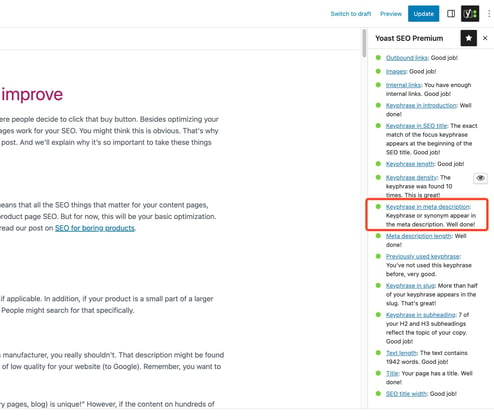
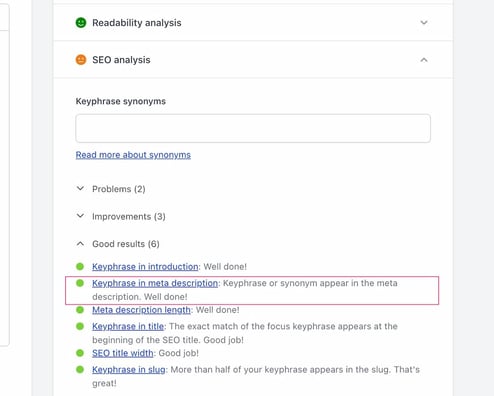
How to get a green traffic light for the keyphrase in meta description
You’ll get a red traffic light if you don’t mention the keyphrase in the meta description. So, make sure to write one. But don’t stuff your meta description with your keyphrase because that will also get you a red traffic light. And make sure to mention all the words from your keyphrase near each other. Search engines are pretty smart nowadays, but you must clarify what your page is about.
Yoast SEO Premium plugin considers the synonyms you’ve added when it performs its analysis. This allows you to write more naturally, resulting in a more pleasant text. Moreover, it’s easier to score a green traffic light this way. Use it to your advantage!
Unlock all features in Yoast SEO Premium
Save time on your SEO and get access to all of our SEO courses.
What does the meta description length assessment do?
This meta description length assessment measures whether your description is too short (less than 120 characters) or too long (more than 156 characters). You’ll get a green traffic light when your meta description has the right length. If it’s too long or too short, you’ll get an orange traffic light in the SEO analysis of Yoast SEO (or red if you’ve marked your article as cornerstone content).

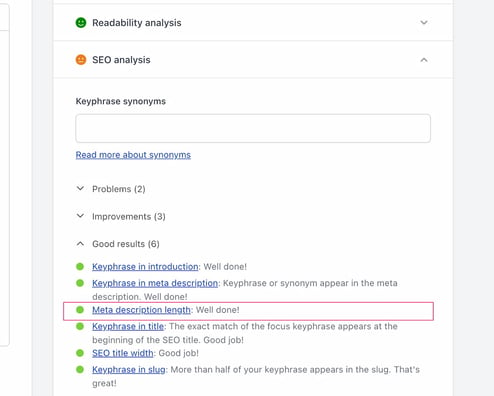
How to write a concise meta description
A good meta description convinces people that your page offers the best result for their query. But, to be the best result, you must know what people seek. What is their search intent? Are they looking for an answer to a question? If they are, try to give them the most complete answer. Are they looking for a product? Write down what makes your product stand out and why they would best buy it in your store. Be concise and convincing!
You get real-time feedback on the meta description length in the Search appearance section in the Yoast SEO sidebar or meta box. Click “Search appearance” in the Yoast SEO sidebar to write a meta description. This will open the snippet editor, and you’ll see input fields for editing the SEO title, the slug, and the meta description. When you start typing in the meta description input field, the snippet preview at the top of the Search appearance editor will immediately show your new text. Underneath the input field, there is a bar. It’s orange when you start typing and will become green when you’ve added enough information. When you add too much text, it will turn orange again.
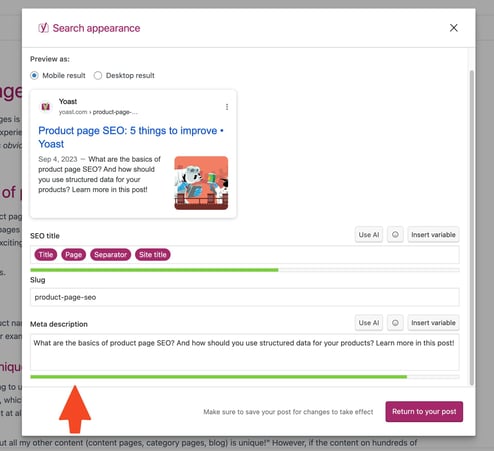
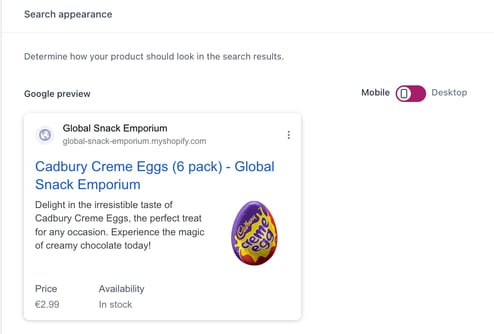
Writing or editing your meta description in the Yoast SEO meta box underneath your post editor is also possible. Go to the SEO tab in the meta box (if it’s not on this tab by default), and you can start typing in the field under Meta description immediately.
What to do if you need meta descriptions for a lot of pages?
After reading this, do you need to change all your meta descriptions? But are you not sure how to fit that into your schedule? Google has the answer:
“If you don’t have time to create a description for every single page, try to prioritize your content; at the very least, create a description for the critical URLs like your home page and popular pages.“
Advice from Google Search Central documentation
You can check which of your pages ranks highest with Google Search Console. Take it from there. It’s also possible to optimize your meta descriptions with variables in Yoast SEO. This allows you to speed up this process without worrying about duplicate descriptions.
If you prefer to write a unique description for each page and have much to get through, you can use the Bulk editor tool in Yoast SEO for WordPress. Head to the Tools page, click ‘Bulk editor’, then select the ‘Description’ tab. You’ll be able to see any meta descriptions already set for your pages, and you can quickly add new ones without opening each page individually. However, with this tool, you won’t get warnings if your description is too short/long, or if the focus keyword is missing.
Preventing snippets with Yoast SEO
Yoast SEO provides an easy way to control search result snippets using the nosnippet meta tag feature. This setting lets you prevent Google from displaying any snippet for particular pages, giving you control over what appears in search results. It’s especially useful when you want to prioritize privacy or ensure that content is not shown without its full context. With the nosnippet tag, you have another way to manage snippet creation and to align everything with your content strategy.
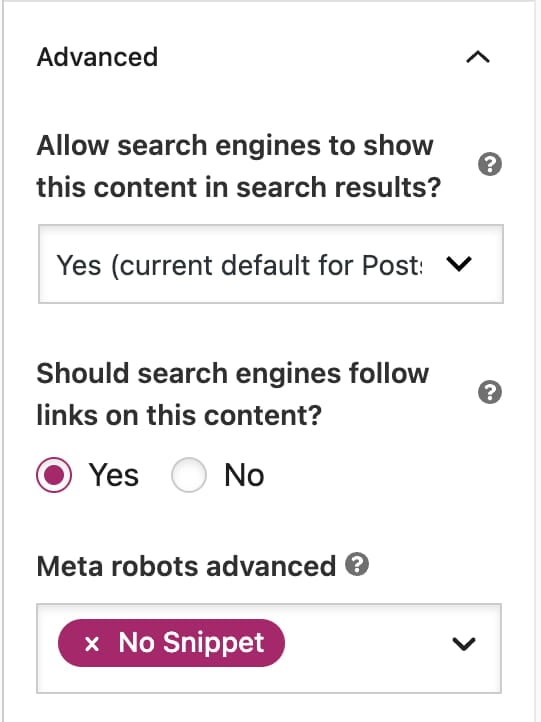
Meta descriptions for social sharing
Do you have Yoast SEO? Check the Social media appearance in the Yoast SEO sidebar or social tab in the Yoast SEO meta box below your post or page. You can add a separate description for your social media channels there. In Yoast SEO Premium, you even have social previews that show you what your post or page will look like when shared on social media.
Conclusion to meta descriptions
Meta descriptions are a crucial yet often underestimated component of SEO — even if these are not fully in your control. It serves as a brief advertisement for your content in search results, influencing click-through rates and user engagement. Crafting clear, compelling, and keyword-rich meta descriptions can significantly enhance your online visibility. In return, it could attract more targeted traffic to your website. While they may not directly impact rankings, their role in driving clicks and conversions is undeniable.
A well-crafted meta description is not just about SEO; it’s about creating a better user experience by providing searchers with a clear, concise preview of what to expect on your page. Of course, Google might think it knows better than you, but that doesn’t mean you shouldn’t put your best foot forward!
Read more: How to use the Google preview in Yoast SEO »

